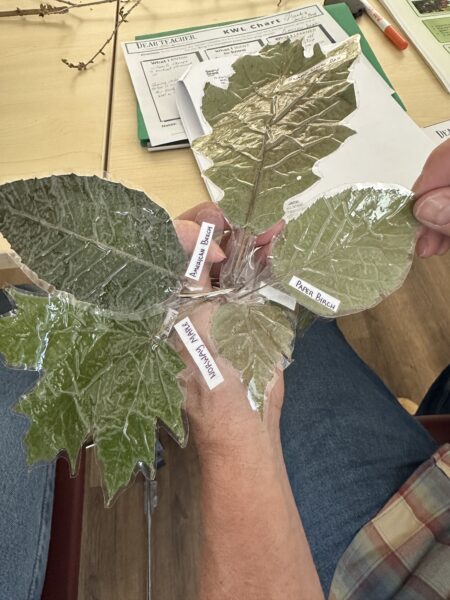
30 Ways to Bring Environmental Education into Your Classroom
The Backstory:
In March 2025, IRW gathered 40 Washington County educators at the beautiful Cobscook Institute in Trescott, Maine for a day of hands-on professional development: Dear Teacher, The Climate Education Edition! Generously funded by a grant from the Maine Department of Education Climate Education, the day’s program included keynote speaker Jane Disney of the MDI Biological Laboratory and four workshop facilitators.
Maine Climate Education is a place-based, age-appropriate, interdisciplinary approach to “understanding of how the climate system works, how human actions influence climate, and how climate influences people and other parts of the Earth system.” (NOAA)
We asked our presenters to help classroom teachers lay the foundation for approaching climate education. Their workshops focused on outdoor, place-based education, exercises for sharpening observation skills, resources for studying phenology, and integrating learning about the natural world with writing and art.
We’ve rounded up 30+ resources that you can use to bring environmental & climate education into your classroom!
Resources (for extended learning & fun!)
- Citizen Science for Your Classroom: Cornell Bird Cam Lab, Maine Public
“Bring video of birds from around the world into your classroom and strengthen students’ observation and questioning skills with Cornell Bird Cams.” **Includes resources for introducing citizen science to kids in grades K–5 as well as activities and discussion questions for use with the Bird Cam!** - “2 ways to better integrate literacy and science instruction,” District Administration
“At a time when research points to continued declines in reading and science achievement, new data encourages educators to blend.” - Get Ready To Teach Earth Month: Inspire Hope & Student Engagement, PBS LearningMedia
“Join PBS LearningMedia and KQED on April 1st for a one-hour webinar to explore how positive stories about the environment can engage the next generation of changemakers. Educators will leave with resources that ignite hope and inspire action.”
From Our Workshops
- Signs of the Seasons: a New England Phenology Monitoring Program, Maine SeaGrant
A resource from Keri Kaczor’s workshop. Participants help scientists document the local effects of global climate change by observing and recording the phenology (seasonal changes) of common plants and animals living in their own backyards and communities. - Project WILD, Maine Department of Inland Fisheries and Wildlife
From Cathy Lookabaugh’s workshop. Project Wild is a series of activity guides that can be used as part of any class instruction, designed for pre-K through 12th grade. - Maine Outdoor School & The Nature of Phenology Podcast
Find Hazel Stark of Maine Outdoor School. Listen to The Nature of Phenology with your class—a weekly short podcast episode that describes what’s happening in Maine’s natural world. - Kim Ridley’s website & the IRW Zine Resource Library.
Kim’s site is packed with great info on her books as well as resources for teachers. In the Zine Resource Library, find a printable template for making these little booklets Kim discussed, as well as 6 prompts for environmental education zines!
More Phenology Resources from Keri
- Phenology Resource Folder: Here you’ll find the Workshop presentation, springo, nature cards (pdfs), and other useful resources.
- Canva Links to modify the Nature Cards:
Additional Resources
- Phenology Journaling and phenology wheels
- How to draw species: Common Dandelion, American Robin, Wild Strawberry, Common Lilac, Eastern Chipmunk, American Toad, Monarch Butterfly, Red Maple
- Leaf Identification Ring
- Wabanaki Medicine and Moons
|
Signs of the Seasons: A New England Phenology Program |
Article, How monitoring phenology helps us understand climate change List of indicator species |
|
GLOBE Green-Up Phenology Resources |
Budburst Green-Up Data Collection (GMRI Version) Phenology and Plant Growth Learning Activities by grade Elementary Storybook: The Mystery of the Missing Hummingbirds North American Phenology Campaign Page GLOBE Data Visualization System Scientist to Go with UNH’s Dr. Alix Contosta focused on changes to spring phenology, May 22, 10AM (live-streamed meeting for students and classrooms) It is easy to become a GLOBE Educator which lets you enter your own data and have access to experts to speak with you and your students. Do the GLOBE eTraining here to become certified (or reach out to rlea@gmri.org) |
|
National Phenology Network |
|
|
Climate Central Resources |
